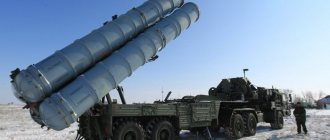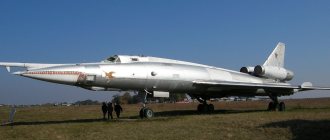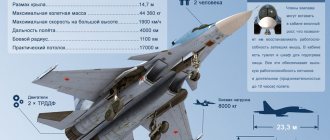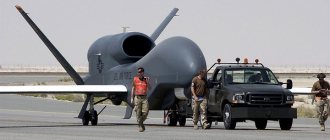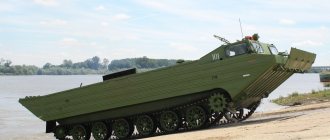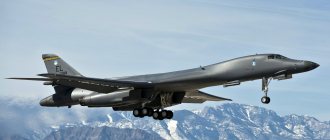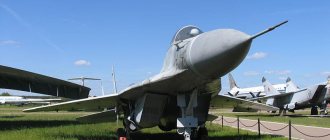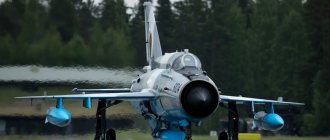Tu-22M3 is a long-range bomber, a modification of the Tu-22 strategic bomber known in the Soviet Union. We can say that strategic aviation received a qualitative leap in its development as Soviet-American relations deteriorated.
At their core, both superpowers were constantly developing their nuclear capabilities. But delivering the deadly cargo to enemy territory required appropriate technical capabilities.
This is how the Tu-22 was born, which was designed to withstand the best American analogues, the B-58 and A-5.
Nicknamed “an awl” among pilots for its similar shape, the Tu-22 incorporated all the most modern and ahead of its time technologies, allowing the USSR to compete on an equal footing with the United States in strategic aviation for a long time.
But his story was not cloudless. The first prototypes of the aircraft were so unreliable that accidents and disasters followed the Tu-22 aircraft relentlessly. It got to the point that there were cases when pilots refused to take off on these strategic bombers.
History of creation
Immediately after the end of World War II, nuclear weapons were created. Over time, the question arose about how to deliver it to enemy territory. Thus began the famous arms race of the Cold War.
Two warring parties, the flagships of that time in the field of military developments - the USA and the USSR, laid the foundation for strategic aviation.
At first, the Soviet side noticeably lagged behind their American counterparts. The very creation of man's deadliest weapon, the nuclear bomb, happened later than in the United States. The weapon delivery vehicle used in the Union was the Tu-4 long-range bomber.
In fact, it was a copy of the American B-29 bomber.
But these aircraft were practically unable to effectively carry out strategic missions. The piston engines used could not provide high flight speed, and the relatively short range of non-stop operation did not guarantee a 100% possibility of delivering a nuclear strike on enemy territory.
But technology developed, and soon made it possible to take a big step in the development of strategic aviation. Already in the 50s of the 20th century, “strategists” reached and overcame the speed of sound.
In those days, supersonic flight at high altitude guaranteed the completion of all combat missions. Neither country's air defense systems had the capabilities to destroy such objects. And, this meant an almost 100% probability of delivery of weapons of mass destruction and a lost war.
The USSR responded to the successful models of the American Air Force: B-58 and carrier-based A-5 “Vigilent” with Myasishchev and Tupolev strategic bombers: M-50 and Tu-22.
The creation of multi-mode supersonic bombers required designers to introduce new technologies, materials and often revolutionary solutions into the aircraft industry.
The aircraft designed at that time have long since gone down in history, but nevertheless, it was on their basis and experience that modern aircraft were created that took their rightful places in the “nuclear triad.”
The life countdown for the Tu-22 aircraft began in 1954. The brilliant designer Andrei Nikolaevich Tupolev immediately developed two projects for qualitative improvement of the Tu-16 bombers existing at that time.
During the analysis and long discussions, the Tu-22 variant was chosen, which took off for the first time in 1958. The plane had a classic layout, with a rather interesting, but nevertheless somewhat unsuccessful at that time engine placement.
They were installed on top of the fuselage, in the rear of the aircraft, directly under the fin. This arrangement created problems in the future, during operation at combat airfields. The Kazan Aviation Plant began production of the new aircraft.
During the tests of the Tu-22, it turned out that not everything went smoothly. The bomber did not produce the predicted results for maximum speed and flight range. Thus, the flight speed was up to 1450 km/h, although it was originally planned to reach 1500-1600 km/h. The flight range was also lower than predicted.
Despite the shortcomings, the Tu-22 continues to be improved, and in 1962 they begin to be delivered to long-range aviation combat units for service.
The adoption of the Tu-22 into service in economic terms made a fairly large hole in the budget of the Ministry of Defense. The landing and takeoff modes of the new bomber required the reconstruction of some strategic aviation airfields, since landing the Tu-22 required at least 3 kilometers of runway.
But all these shortcomings pale in comparison with the main disadvantage of the car. From the very beginning of test flights, it became clear that the Tu-22 suffered accident after accident due to equipment and instrument failures, as well as various breakdowns and malfunctions.
There are statistics according to which more than 70 vehicles were lost before 1975. For comparison, until 1990, 311 cars were manufactured. It turns out that about 20% of them had emergency landings.
They were able to modify the car and get rid of frequent failures only by the 1970s of the twentieth century. But even after the accident they continued, albeit in smaller quantities.
The Tu-22 has received a bad reputation as one of the most unreliable aircraft in the history of Russian aviation. There were known cases when pilots simply refused to take off on this plane.
But such failures were associated not only with a high accident rate, but also with the great complexity of the aircraft to control. The Tu-22 crew did not include a co-pilot and a navigator, which was not the best solution for such heavy vehicles.
The already difficult management was made even more stressful by the additional responsibilities assigned to each crew member. In reality, only first class pilots could fly such aircraft.
The Tu-22 was distinguished by its high takeoff and landing speed.
At that time, there was not a single effective simulator on which these important processes could be worked out. Therefore, the introduction of vehicles into the troops was accompanied by frequent accidents. People died, airfields and equipment were damaged.
High speeds during landing carried a very large load on the landing gear. It is known that there were cases when one of the wheel struts folded, and the ADD lost both the aircraft and the trained crew.
The ergonomics of the cabin were also far from perfect. Many levers and toggle switches were located so far away that they had to be reached, and the frequency of their use was often very high.
As a result, the crew members got tired quite quickly during a long flight, and their attention was dulled, which also negatively affected the accident rate of the vehicle.
The poorly positioned engines received a lot of criticism. At high speeds, the car often lost control and became uncontrollable. During the flight, the skin of the aircraft became very hot and deformed due to very high temperatures.
To all this we can add very great difficulties with servicing the bomber. The flight required lengthy preparation, which normally took 3.5 hours.
And the preliminary preparation of all aircraft systems could take a whole working day. The engines were located at a very high altitude, so any breakdown took longer to repair than on other aircraft.
But all these numerous mistakes made it possible to create a fundamentally new machine, the Tu-22M. Despite the similar name, the new aircraft was very different from its predecessor. The developers took into account many of the inconveniences and changed the design of the aircraft in such a way as to make one of the best examples of strategic aviation in the world.
ON THE THIRTY ANNIVERSARY OF THE FIRST FLIGHT OF THE TU-22M3 AIRCRAFT(Continued. Started in No. 6/2007)
The material was prepared by the press service of JSC Tupolev at the request of the magazine
Tests of the first Tu-22M3 showed that in terms of their flight and tactical characteristics, the aircraft of the new modification are significantly superior to the Tu-22M2. Almost in terms of flight characteristics, it was possible to reach the requirements of 1967, with a significant increase in the combat capabilities of the aircraft and the entire complex. Joint state tests of the Tu-22M3 were completed in 1981, and the aircraft was recommended for adoption.
From 1581 to 1984, the aircraft underwent an additional set of tests in a version with expanded combat capabilities, including the version equipped with aeroballistic missiles. New weapons systems required additional time for their development and testing, so in its final form the Tu-22M3 was officially accepted into service only in March 1989.
Prospects for the development of the Tu-22M3 complex are associated with the modernization of on-board equipment, the retrofitting of promising high-precision weapons systems and the provision of the necessary resources and service life of the carrier aircraft airframe, its systems and equipment.
The main goals of modernization are:
– expansion of the complex’s combat capabilities;
– increasing the defensive capabilities of the aircraft when performing a combat mission, navigation accuracy, reliability and noise immunity of communications;
– ensuring the effectiveness of new generation missile weapons and bomber weapons, both guided and unguided.
In terms of modernizing the avionics on the Tu-22M3, it is necessary to install a new multifunctional radar with expanded capabilities and increased noise immunity. The avionics units and equipment require a transition to a new modern element base, which will allow for a reduction in the dimensions and weight of the avionics, and should also reduce the energy consumption of the equipment.
The proposed measures to modernize the avionics, together with the ongoing work to extend the service life indicators, will ensure the possibility of effective operation of this aviation complex until 2025 - 2030.
The OKB constantly carries out all these activities, improving and developing the basic design of the Tu-22M3 complex, having designed several options for its development since the creation of this complex.
As noted earlier, in addition to the main variants of the long-range missile carrier-bomber armed with bombs and Kh-22N missiles, a version was prepared armed with anti-radar missiles based on Kh-22N missiles and aeroballistic missiles.
By the beginning of the 80s, the Design Bureau prepared and transferred into production several modifications of the Tu-22M, which differed from the basic ones in the composition of weapons and equipment.
The introduction of reconnaissance and target designation equipment into the sighting system made it possible to equip the Tu-22M with anti-radar missiles, and then with aeroballistic missiles of various types. First, this work was carried out in relation to the Tu-22M2, and then to the Tu-22M3. In the 80s, these works were crowned with success - the serial Tu-22M3 also received a version of missile weapons with aeroballistic missiles on the intra-fuselage MCU and on wing ejection installations.
Tu-22MR in flight
Tu-22MR in combat unit
In December 1985, flight tests of the experimental Tu-22M3R long-range reconnaissance aircraft, designed on the basis of the Tu-22M3, began. The new reconnaissance aircraft was intended to replace Tu-22R reconnaissance aircraft in combat units. The new reconnaissance aircraft was equipped with a modern photo and radio reconnaissance complex, which, combined with the high flight qualities of the carrier aircraft, ensured a significant increase in the effectiveness of aerial reconnaissance. The airborne reconnaissance complex provides solutions to operational-strategic reconnaissance tasks in land and sea theaters of military operations and includes modern airborne photo, electronic, radar, infrared and radiation aerial reconnaissance equipment.
In 1989, the reconnaissance aircraft under the designation Tu-22MR was put into mass production.
In terms of its performance characteristics, the Tu-22MR is fully consistent with the basic attack version of the Tu-22M3. The differences are in the presence of an on-board reconnaissance complex, an on-board radar, and an electronic reconnaissance complex.
Externally, the Tu-22MR differs from the Tu-22M3 by the presence of a ventral fairing for the reconnaissance equipment container, an elongated fin gargrot and small identification surfaces on the wing tips.
Tu-22MR entered service with the Russian Air Force (in service since 1994).
As in the case of the basic strike complex Tu-22M3, a promising modernization program has been developed for its reconnaissance version, including, in particular, the introduction of a new, more effective reconnaissance complex, as well as the modernization of the aircraft's avionics.
To replace the Tu-22PD jammer aircraft, in the 70s an attempt was made to create a jammer based on the Tu-22M.
During this work, the serial Tu-22M2 was converted into a stager. The aircraft, designated Tu-22MP, was tested, but was not put into production and service due to the lack of development of the REP complex. Subsequently, the idea of a specialized group REP aircraft was abandoned and they relied on equipping serial Tu-22M3 with new effective REP complexes for individual and group protection, which began to be installed on the Tu-22M3 in the second half of the 80s.
As noted above, it was planned to install NK-32 engines on the Tu-22M3, thereby improving its performance and unifying its power plant with another OKB aircraft - the strategic Tu-160.
To test the new power plant, one of the serial Tu-22M3s was converted, but it did not come to the point of installing new engines; later this machine was used as a flying laboratory for testing new types of equipment and weapons.
In 1992, the OKB, together with LII and TsAGI, on the basis of one of the first serial Tu-22M3, created the Tu-22MLL flying laboratory, intended for conducting a wide range of full-scale flight aerodynamic research.
In addition to the listed built versions of the Tu-22M, the design bureau was working on several projects for modifications and upgrades of the aircraft, work on which did not leave the initial stages of design. In 1972, the Design Bureau for Navy Aviation prepared a technical proposal for a radical modernization of the Tu-22M. The project received the designation "45M".
According to the project, the “45M” was to be equipped with two NK-25 or NK-32 engines and have an original aerodynamic layout, to a certain extent reminiscent of the layout of the American reconnaissance aircraft SR-71, combined with a variable-sweep wing.
Strike weapons were supposed to consist of two X-45 missiles.
However, this project was not accepted for further implementation due to difficulties with a radical restructuring of serial production and a corresponding loss in the rate of production and rearmament of the Air Force with new aircraft, which the USSR could not afford at that time.
There were projects to create, based on various modifications of the Tu-22M, the long-range interceptor Tu-22DP (DP-1), capable of fighting not only attack aircraft at large distances from protected objects, but also AWACS aircraft, formations of transport aircraft, and also perform strike functions .
In addition to those listed, there were and are several other projects for the development of the Tu-22M based on the use of modernized engines, new equipment systems and weapons, for example, the Tu-22M4 and Tu-22M5 projects.
Project "45M"
Model Tu-344
Work on the Tu-22M4 complex began in the mid-80s (until 1987, this topic, as a deep modernization of the Tu-22M, continued to bear the designation Tu-32).
The project represented a modification of the serial Tu-22M3 with the aim of further increasing the combat effectiveness of the complex by equipping the aircraft with new equipment and weapons.
First of all, a new sighting and navigation system was introduced, which included a modern navigation system created on the basis of the latest element base; a new airborne radar of the Obzor type was being introduced; modernized electronic control complex; new sighting optical system; individual units of external and internal communication equipment were replaced by a single complex; a system for pressurizing fuel tanks using liquid nitrogen was introduced, etc.
The new composition of the equipment ensured the use of both standard missiles and systems of high-precision bomber and missile weapons as part of the missile weapons complex. According to the program for creating the Tu-22M4, an experimental aircraft was built by the beginning of the 90s, but in 1991, for financial reasons, work on the topic was practically curtailed in favor of a cheaper program of “small modernization” of serial Tu-22M3 for a modernized flight navigation system and missile control system.
The prototype Tu-22M4 aircraft was used to carry out work on further modernization of the complex.
In 1994, the OKB, on its own initiative, developed a project for further modernization of the serial Tu-22M3 and development of the Tu-22M4 theme. Increasing the combat effectiveness of the complex was supposed to be due to: increasing the range and updating the composition of weapon systems with an emphasis on high-precision weapons; further modernization of avionics; reducing the signature of the carrier aircraft; improving the aerodynamic quality of the aircraft (modifying the wing contours, improving local aerodynamics and the quality of external surfaces).
The planned composition of the missile weapons complex was supposed to include promising high-precision anti-ship missiles for tactical purposes and air-to-air missiles (for self-defense and for the complex to perform the functions of an escort aircraft and a “raider”), modern free-falling and guided (adjustable) bombs were introduced into the bomber weapons system .
The modernized avionics were supposed to include: the latest sighting and navigation system, a modernized weapon control system; airborne radar "Obzor" or a promising new radar; modernized communications complex; a modernized REP complex or a new promising complex.
According to the aircraft airframe, modifications were made to: the nose of the aircraft; socks of the middle part of the wing and the rotating part of the wing; fairings over the wing turning units; aft rear part of the fuselage; rudder.
Especially for deliveries abroad, the Design Bureau has developed an export version of the Tu-22M3 - the Tu-22M3E aircraft, which has some differences in the composition of weapons and equipment, taking into account the latest improvements in the serial Tu-22M3 in terms of avionics, the requirements of potential foreign customers, as well as the international obligations of the USSR and the Russian Federation. Federation. Countries such as India, China, Libya, etc. can be considered as potential buyers of the aircraft.
In addition to these works on the development of the Tu-22M, the OKB, as part of conversion programs in the second half of the 90s, considered the Tu-344 administrative class SPS project for 10-12 passengers, the creation of which was supposed to be based on the Tu-22M2 or Tu-22M3 aircraft.
The Design Bureau is considering the possibility of creating a promising aerospace system (AKS) on the basis of the Tu-22M3 carrier aircraft.
It should be noted that in the field of aerospace systems, the Design Bureau considers two areas as the most appropriate and with prospects for implementation and further development.
The first direction is the creation of commercial systems based on existing Tu-160 and Tu-22M3 carrier aircraft for the rapid launch of relatively small payloads into low-Earth orbit
The second direction is the development and flight testing of experimental complexes for testing elements of future hypersonic aircraft, including AKS and VKS, primarily hypersonic ramjet jets.
The use of the Tu-160 as a carrier aircraft makes it possible to launch a payload weighing up to 1100 - 1300 kg into low Earth orbit. This topic has been studied quite deeply at OKL within the framework of the AKS “Burlak” project.
Maintenance of Tu22MZ
Tu-22M3 cockpit
In contrast, the aerospace complex based on the Tu-22M3 carrier aircraft can ensure the launch of a payload weighing 250-300 kg into orbit. This OKB project, according to its developers, has more prospects for practical implementation than the AKS based on the Tu-160, due to the larger number of potential carrier aircraft and a larger possible network of airfields.
Recently, a clear trend has emerged throughout the world in the transition from heavy and expensive multifunctional spacecraft to the use of small spacecraft created on the basis of the latest achievements in microminiaturization of on-board payload equipment and spacecraft service systems. Thanks to this trend, the cost of space technology launched into orbit is reduced by 20-30% per year, and the time required to create new spacecraft is reduced from 8-10 years to 2-3 years; the costs of their creation quickly pay off. In the class of small spacecraft, up to 20 devices weighing up to 250 kg are launched annually. In this class, spacecraft are created for the following purposes: spacecraft for mobile communication systems (weighing 40-250 kg); Earth remote sensing spacecraft (weighing 40-250 kg); technological and university spacecraft (weighing 10-150 kg).
Currently, the main means of launching small spacecraft continues to be disposable ground-launched launch vehicles. The transition to AKS, and in particular to AKS based on the Tu-22M3, will significantly reduce the cost of launching payloads and will provide a number of operational and tactical advantages compared to launches using ground-launched rocket launch vehicles. According to OKB estimates, an aerospace complex based on the Tu-22M3 can be created and brought to the stage of commercial use in 3–4 years.
In the second direction (creation of videoconferencing and work on hypersonic aircraft), based on the Tu-22M3 carrier aircraft, a flight experimental complex can be created to test the accelerator of the hypersonic flying laboratory "Raduga-D2" developed by the State Design Bureau "Raduga", which can provide launch to the desired trajectory of an experimental apparatus with a scramjet engine operating on conventional hydrocarbon or cryogenic fuel.
According to its layout and design scheme, the Tu-22M3 is a twin-engine all-metal low-wing aircraft with two turbofan engines installed in the rear part of the fuselage, with a variable-sweep wing in flight and a swept tail, with a tricycle landing gear with a front support. The design of the airframe and its components mainly uses aluminum and titanium alloys, high-strength and heat-resistant steels, and non-metallic structural materials.
The wing consists of a fixed center section - the middle part of the wing (MSW) and two rotating parts (PCHK) - consoles having the following fixed positions along the sweep angle: 20, 30 and 65 degrees. The angle of the transverse “V” of the wing is 0 degrees. The rotary console has a geometric twist, the twist angle is 4 degrees. The sweep of the SCHK along the leading edge is 56 degrees. The center section is two-spar with a rear wall and load-bearing skin panels. The rotating consoles are attached to the center section using pivot joints. The wing mechanization consists of three-section slats and double-slotted flaps on the consoles and a rotary flap on the center section. Provision is made for blocking the release of flaps and slats at sweep angles of more than 20 degrees. The consoles are equipped with three-section spoilers for roll control (there are no ailerons on the aircraft). The rotation of the wing consoles is carried out using an electro-hydraulic system using hydraulic drives with ball screw converters connected to each other by a synchronizing shaft.
The fuselage is of semi-monocoque construction, reinforced with powerful longitudinal beams (beams) in the cargo compartment area. The forward part of the fuselage houses a radar, a crew cabin designed for four people (ship commander, assistant ship commander, navigator-navigator and navigator-operator), equipment compartments, and a niche for the front landing gear. The crew's workplaces are equipped with KT-1M ejection seats. In the middle part of the fuselage there are fuel tanks, niches of the main landing gear, a cargo compartment, and air intake channels. At the rear of the fuselage are the engines and the braking parachute compartment.
The vertical tail consists of a forkeel and a technologically detachable keel and rudder. The keel sweep is 57 degrees. The horizontal tail consists of two solid-rotating consoles with a sweep of 59 degrees. The consoles are controlled hydraulically using steering drives.
The landing gear is tricycle, the nose gear is two-wheeled, and can be retracted back in flight. The main supports are three-axle, six-wheeled, retractable into the wing and partially into the fuselage. The wheels of the main supports are equipped with hydraulic disc brakes and automatic anti-skid devices. The wheels of the main supports have a size of 1030×350, the front ones – 1000×280.
The power plant includes:
two two-circuit turbofan engines with afterburners NK-25;
adjustable multi-mode air intakes with a horizontal controlled wedge and replenishment and bypass flaps; on-board auxiliary installation;
fuel and oil systems;
control and monitoring systems for power plant units.
The turbofan engine has a maximum afterburning take-off thrust of 25,000 kgf and a maximum non-afterburning take-off thrust of 14,500 kgf. The TA-6A auxiliary power unit provides engine starting on the ground, power to the on-board AC and DC power supply on the ground and in failure cases in flight, powering aircraft systems with air on the ground and in some specified cases in flight. The fuel is placed in the fuselage and wing (center section and console) protected fuel tanks, equipped with a neutral gas filling system, as well as a tank in the fork. Scoop-type air intakes with a horizontal wedge are equipped with make-up and bypass flaps, as well as an automatic air intake control system.
Takeoff of Tu-22M3
The digital flight and navigation system of the aircraft with inertial navigation systems provides: automatic solution of navigation problems; manual, automatic and semi-automatic cross-country flight in a horizontal plane with provision of pre-landing maneuver and approach; issuing the necessary information for the aircraft to automatically enter a given area at a given time; issuing the necessary information to the aircraft crew, as well as to the complex systems.
The aircraft is equipped with on-board long- and short-range radio navigation equipment (RSDN and RSBN), an automatic radio compass, and a PNA-type targeting and navigation radar interfaced with the Kh-22N missile control system. The aircraft is equipped with a blind landing system, high and low altitude radio altimeters. Communication with the ground and aircraft is carried out using VHF and HF transceiver radio stations. In-flight communication between crew members is carried out using an aircraft intercom.
Missiles of the Kh-22N type are placed: the fuselage missile in a semi-recessed position in the fuselage cargo compartment on a retractable beam holder BD-45F, the wing missiles - on pylons, on beam holders BD-45K. Aeroballistic missiles - on MKU and ejection wing installations.
Bomb loads of various types are placed in the cargo compartment on bomb holders of cassette and beam type. For external suspension - on multi-lock beam holders.
Aiming during bombing is carried out using a radar and an optical bomber sight with a television set-top box.
The aircraft's defensive armament consists of a cannon armament system with a GSh-23 type cannon with a telesight and a VB-157A-5 computing unit coupled with a small-arms radar sight. The aircraft is equipped with a developed electronic control system and a passive jammer.
A modified version of the serial Tu-22M3 in the export version Tu-22M3E, taking into account the specific requirements of the customer, is offered to foreign customers with a slightly different set of strike weapons. The complex, in addition to using the export version of the Kh-22ME, has expanded capabilities for the use of various types of missiles, including missiles adopted in service in these countries, for example, Brahmos missiles, developed jointly by Indian and Russian enterprises.
The first of the combat units in Long-Range Aviation to receive the Tu-22M was the 185th Guards TBAP in Poltava. The regiment's personnel were retrained on the Tu-22M2 from the Tu-16. The regiment quickly mastered the new vehicles and complex. In the same 1974, Tu-22M2 began to enter combat units of the Navy aviation. During the 70s and 80s, several more DA and Navy aviation regiments switched to the Tu-22M2 and Tu-22M3. After the collapse of the USSR, Tu-22M remained only in the air forces of Russia and Ukraine (the last Tu-22M3 was dismantled in Ukraine last year). Tu-22M2 and Tu-22M3 aircraft took part in combat operations during the Afghan War; to a limited extent, Tu-22M3 took part in anti-terrorist operations in the Chechen Republic.
Currently, a significant number of Tu-22M3s continue to be used by Long-Range Aviation and Navy aviation; all Tu-22M2s remaining in service in the early 90s were withdrawn from the Air Force and disposed of as redundant for the changed structure of the Russian Air Force.
The long-term successful operation of the Tu-22M3 complex, its high modernization potential, as well as the flight and tactical characteristics achieved during its many years of development allow us to speak of it as a unique means of combat in land and sea theaters of military operations, including as an effective means combating aircraft carrier strike groups, as well as both a means of delivering modern aircraft weapons to destroy a wide range of targets in the operational-tactical depth of battle formations in the case of local conflicts, and in the event of a global conflict using weapons of mass destruction, in the conditions of the use of modern air defense systems.
Bottom view of the Tu-22M3
Personalized plane "Alexander Molodchiy" of the Ukrainian Air Force in the aviation museum in Poltava
Tu-22M3 with the Russian flag painted on the side
All this became possible not only thanks to many design features incorporated into the basic design and developed during the development of the complex, but also to the high performance characteristics obtained both for the aircraft and for the entire complex as a whole. For example, in operation the Tu-22M3 can be used with more than ten weapons options. Moreover, the transition from one weapon option (missile, bomber or mixed) to another is ensured in operation in the shortest possible time.
Conducting tactical flight exercises using the Tu-22M3 in various regions of the country showed that the aircraft can be operated from operational airfields with minimal costs for preparing equipment and weapons. This was clearly confirmed during the participation of the Tu-22M3 in combat operations in Afghanistan and the North Caucasus.
The successful use of the Tu-22M3 complex was facilitated by a proven operating system, which included:
– logistics support, the main task of which was the supply of technical equipment, ground support equipment, fuels and lubricants, spare parts, consumables and ammunition for carrying out all types of work on the aircraft and its combat use;
– radio technical support, which made it possible to carry out aircraft flights both in the area of the airfield and at great distances from it;
– other types of material and technical support that allow the effective use of the Tu-22M3 complex.
An aircraft (a formation of aircraft) can be prepared in the shortest possible time for relocation to an operational airfield located at a distance of 5000-7000 km from the main airfield. Weapons for the first combat mission are usually transported on board the aircraft. The presence of the Armed Forces makes it possible to prepare for combat operations immediately after landing at the operational airfield. The proven operating system of the complex makes it possible to prepare the aircraft at the base airfield using stationary ground support equipment, and at operational airfields using available mobile maintenance equipment and technical first aid kits used by the ITS during relocation.
All this allows the complex to be effectively used in any theater of military operations, in various latitudes and climatic zones, both at base and operational airfields.
Considering the large residual life of the existing Tu-22M3 aircraft and the fact that the Russian Air Force has a fairly large number of Tu-22M3 aircraft, the Design Bureau continues work on further modernization of the Tu-22M3 fleet. As noted above, the aircraft should receive high-precision weapons and updated avionics. The Design Bureau is also constantly working to increase the resource indicators of the complex and its component parts. Modernization programs for the Tu-22M3 should significantly increase the strike potential of the aircraft and the complex, ensuring its effective operation for at least another 20-25 years. Thus, the Tu-22M3 with modernized on-board equipment, retrofitted with high-precision weapons, will form a significant part of the combat strength of the strike forces of the Russian Long-Range Aviation and Navy Aviation for many years to come.
Victor MARKOVSKY, Igor PRIKHODCHENKO
Table of contents
Design and technical characteristics
Perhaps the most important feature of the Tu-22M3 long-range supersonic bomber is its variable wing geometry. This property is due, first of all, to the fact that modern strategic aviation must be able to perform combat missions at different altitudes and speeds (subsonic and sonic).
There are cases when Soviet pilots performed real miracles, flying such a large machine at such a low altitude that it was not noticed by the radar defenses of a potential enemy.
So, in 1986, during major exercises of the Soviet fleet and aviation in the Black Sea, two bombers quietly crossed the borders of NATO countries twice.
The Tu-22M3 can change its wing sweep during flight.
When constructing the Tu-22M3, titanium and aluminum alloys are used, which provide high resistance to high temperatures. Thus, it was possible to avoid a huge number of failures that occurred on its predecessor, the Tu-22.
Today, there are 40 Tu-22M3 aircraft in service with the Russian Air Force. It is planned that by 2022, 30 of them will be updated to the Tu-22M3M modification. The new models will receive the most modern electronics, communications equipment and the latest weapons.
The aircraft fuselage is a semi-monocoque. In terms of its aerodynamic configuration, it has a shape close to the classical one. There are five compartments inside it. The nose section is dedicated to the cockpit.
Afterwards there is a radar station, which is covered with a cap capable of transmitting radio waves.
The third compartment is a place for the landing gear and fuel tanks. Also, in the fourth compartment there are additional fuel tanks and a bomb bay. The fifth compartment housed the engines. The engine air intakes are located on the sides of the fuselage.
The engines on the new aircraft were replaced with an improved model RD-7M2.
These engines are more reliable than those previously installed on the aircraft; in addition, they have significant reserves for modernization and sufficient thrust-to-weight ratio.
The Tu-22M3M rests on three landing gear. To reduce the braking distance when landing with a large load or the airfield runway is not long enough, a parachute braking system is provided.
The container is installed below the engines and upon landing throws out two cruciform parachutes.
The crew is housed in an F-2 pressurized cabin, with individual ejection systems in the form of KM-1M seats. The chair is ejected upward and is available from a height of 350 meters.
The aircraft provides both individual and forced ejection. The latter is possible at the discretion of the ship's commander: he has a special toggle switch for this purpose.
Technical characteristics of the Tu-22M3 strategic bomber:
| Maximum speed | 2300 km/h |
| Non-stop flight | Up to 6800 km |
| Aircraft weight with combat load | 124 t |
Kh-22 cruise missiles or Kh-15 aeroballistic missiles are the main armament of bombers. For example, no more than 10 X-15 missiles can be carried on board. Six of them are fixed in a specialized drum inside the fuselage, four are placed under the fuselage and on the center section pylons.
The Tu-22M3 received its nickname “aircraft carrier killer” for its ability to carry Kh-22M anti-ship charges on board, which, at speeds of up to 3,700 km/h, reach targets at a distance of 480 km.
In this case, under the fuselage, in place of the bomb bay, in a semi-recessed form, one X-20 missile is placed, and two X-22 missiles are suspended on pylons
Tu-22M3M flight video
On Saturday, a video recording of the flight of the newest Russian Tu-22M3M bomber appeared on the Internet; it was published by the Zvezda TV channel.
“The newest Russian bomber Tu-22M3M takes off with its wings spread wide. Already when picking up speed and going supersonic, the plane presses its wings, and they change into a “swept” shape. At maximum speeds, the Tu-22M3M flies in this position,” said a commentary on the video on the TV channel’s website. The “swept” wing allows for both high speed and good takeoff and landing characteristics at the same time, the commentary noted.
Lead navigator and aircraft tester Sergei Bolshov told the TV channel that the level of information support in the modernized model has become significantly higher, which greatly simplifies the work of the navigator.
The commentary clarified that the main task of the aircraft is to destroy a wide range of ground and surface targets.
Bomber modifications and participation in wars
The Tu-22 is a long-range bomber that served as the basis for organizing the work of reconnaissance aircraft and electronic warfare aircraft.
The plane underwent a baptism of fire, even though the conflicts in which it participated were regional in nature. The aircraft was exported and served in Africa and the Middle East.
On the side of the Soviet troops, the Tu-22 was used during the Afghan conflict.
The tasks of air regiments armed with Tu-16 and Tu-22 were reduced to carpet bombing. This is both a psychological impact on the rebels and the destruction of scattered groups of militants in difficult terrain. Thus, Tu-22s were widely used during the Panzher operations of OKSVA.
It was after this conflict that the management realized that the Tu-22 was a highly specialized aircraft. Even then, the Aegis BIUS systems with Standard (SM-1/2) missile defense systems that entered service with the United States made it possible to reliably protect aircraft carrier strike formations from attacks by Tu-16 and Tu-22 bombers, but at the same time even the Aegis could not have prevented a massive Tu-22 raid by armed X-22s.
Today, the Tu-22M3 continues to serve in Russian units. But in the near future, a full replacement and improvement of existing machines is planned. We are talking about Tu-22M3M, which will be equipped to the most modern standards.
A distinctive feature of the aircraft will be the latest radar warfare system. Among other things, the new modifications will be equipped with the latest types of cruise missiles.
Armament
The main target for the Tu-22M3 has always been aircraft carrier groups. Therefore, its “main caliber” was the Kh-22 anti-ship cruise missile. This is a rather heavy and “oversized” weapon, with which you can strike surface targets from a distance of up to 600 kilometers.
X-22 anti-ship missile.
The weight of the X-22 warhead is 960 kg. In the “conventional” version, it contains up to 630 kg of special explosive TGAG-5. A nuclear warhead can have a yield ranging from 250 kilotons to one megaton.
The X-22 can fly to a target along a low (11,500 m) or high (more than 22,000 m) trajectory. The speed reaches more than 3.6 M (4000 km/h and above).
The Tu-22M3 can carry from one to three such missiles. The normal combat load is two X-22s.
In 2016, the X-32 anti-ship missile system was put into service - the result of a deep modernization of the X-22. With the same size and speed, this missile has become much more protected from interference. In addition, the flight altitude was increased to 40,000 meters, which made the anti-ship missiles protected from damage by the Aegis air defense system.
The Tu-22M3 could be used to lay sea bottom mines. Depending on their weight and dimensions, from 8 to 18 such ammunition were placed on board.
To destroy ground targets, the Tu-22M3 was armed with Kh-15P aeroballistic missiles. There could be up to ten of them on board: six in a drum unit located inside the cargo compartment, and another 4 under the wing root. The Kh-15P was a kind of ancestor of the modern “Dagger”. This missile flew to the target at a hypersonic speed of 5M, but the destruction range was only 280 kilometers. The Kh-15P was intended to destroy radar stations and the air defense system as a whole.
Unlike the Tu-160, the Tu-22M3 was from the very beginning capable of using conventional free-fall bombs of various calibers, up to 9000 kg, against ground targets. “Mixed” weapons, consisting of both guided missiles and bombs, are also acceptable. The aircraft's normal combat load is 12 tons, which allows it to carry up to 69 FAB-250s.
Aeroballistic missile X-15.


